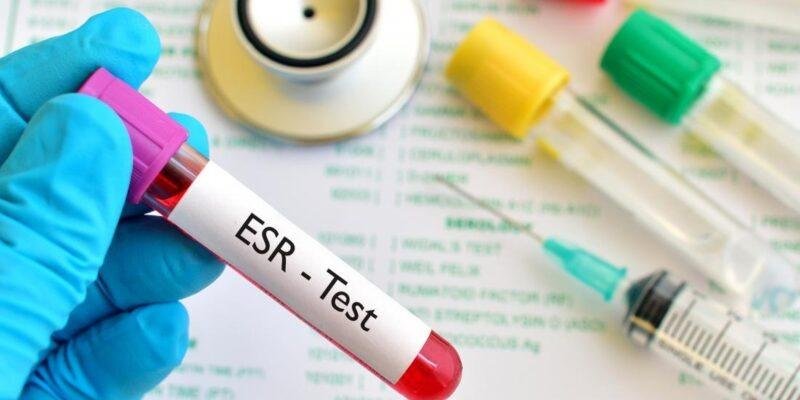The ESR Test (Erythrocyte Sedimentation Rate) is a common blood test that helps detect inflammation in the body. It measures the rate at which red blood cells (erythrocytes) settle at the bottom of a test tube over a period of one hour. While it’s not a definitive test for any specific condition, an elevated ESR can signal the presence of inflammation caused by various conditions such as infections, autoimmune diseases, or cancers.
Purpose of the ESR Test
Diagnosing Unknown Conditions: In cases where symptoms suggest inflammation but the exact cause is unclear, an ESR test may be part of the diagnostic process.
Detecting Inflammation: The ESR test is primarily used to identify inflammation in the body, which can be associated with conditions like rheumatoid arthritis, lupus, or inflammatory bowel disease.
Monitoring Chronic Diseases: It helps doctors track the progression of diseases that cause inflammation over time, such as autoimmune disorders or certain cancers.
Evaluating Treatment Effectiveness: For patients already diagnosed with an inflammatory condition, the ESR test can help evaluate how well treatment plans, such as anti-inflammatory drugs, are working.
Factors That Can Influence ESR Levels
- Age and Gender: ESR levels naturally increase with age and tend to be higher in females.
- Pregnancy: ESR levels are typically elevated during pregnancy due to physiological changes in the body.
- Infection or Illness: An increase in ESR often indicates the presence of infections, such as pneumonia or tuberculosis, or chronic diseases like rheumatoid arthritis.
- Certain Medications: Drugs like oral contraceptives and some chemotherapy medications can elevate ESR levels.
- Anemia: Individuals with anemia may have higher ESR results due to fewer red blood cells in the bloodstream.
Conditions That Cause Elevated ESR
- Autoimmune Diseases: Conditions like lupus, rheumatoi arthritis, and vasculitis are associate with chronic inflammation and can cause high ESR levels.
- Infections: Bacterial infections such as osteomyelitis (bone infection) or tuberculosis can significantly elevate ESR.
- Cancers: Some cancers, particularly lymphoma or multiple myeloma, are link to high ESR levels.
- Kidney Disease: Chronic kidney diseases or nephrotic syndrome can also lead to elevated ESR levels.
- Inflammatory Conditions: Diseases like inflammatory bowel disease (Crohn’s disease or ulcerative colitis) can cause high ESR due to ongoing inflammation in the digestive tract.
Low ESR Levels
A low ESR value, though less common, may occur due to certain conditions such as:
- Polycythemia: An excess of red blood cells.
- Sickle Cell Disease: A condition where abnormal red blood cells slow down the sedimentation rate.
- Congestive Heart Failure: This condition may lead to lower-than-average ESR readings.
- High White Blood Cell Count: Elevated white blood cells may interfere with the test results, leading to a low ESR.
Symptoms That May Lead to ESR Testing
- Joint Pain: Persistent or worsening joint pain, swelling, and stiffness may prompt an ESR test to check for underlying conditions like arthritis.
- Fever: Unexplained fever, especially when it is chronic, may warrant an ESR test to detect potential infections or inflammatory diseases.
- Weight Loss: Unintended weight loss along with fatigue and weakness could indicate an inflammatory or chronic illness, prompting a doctor to order an ESR test.
- Fatigue: Chronic tiredness that doesn’t improve with rest may suggest inflammation or infection that requires ESR testing.
Interpreting ESR Test Results
- Normal Range: The normal ESR value varies depending on age and gender. In general, a low ESR result is considere normal and indicates the absence of significant inflammation.
- High ESR: A high result may indicate the presence of inflammation, infection, or other diseases. However, it is not specific and further tests are usually need for a conclusive diagnosis.
- Follow-up Testing: If your ESR result is abnormal, your doctor may order additional tests, such as C-reactive protein (CRP), to get a clearer picture of the inflammation and pinpoint the cause.
Interpreting ESR Test Results
- Normal Range: The normal ESR value varies depending on age and gender. In general, a low ESR result is considere normal and indicates the absence of significant inflammation.
- High ESR: A high result may indicate the presence of inflammation, infection, or other diseases. However, it is not specific and further tests are usually needed for a conclusive diagnosis.
- Follow-up Testing: If your ESR result is abnormal, your doctor may order additional tests, such as C-reactive protein (CRP). To get a clearer picture of the inflammation and pinpoint the cause.
Why ESR Test is Combined with Other Tests
- Greater Diagnostic Accuracy: The ESR test is often combined with other tests like C-reactive protein (CRP) or complete blood count (CBC) for a more comprehensive view of the body’s inflammatory status. This combination enhances diagnostic accuracy and helps pinpoint the cause of inflammation.
- Tracking Disease Progression: When used in conjunction with imaging tests like X-rays or MRIs. ESR can provide valuable insights into the progression of conditions like arthritis or cancers. Helping doctors make more informed decisions about treatment adjustments.
Conclusion
The ESR Test is a useful tool for detecting and monitoring inflammation in the body, though it is typically used in conjunction with other diagnostic tests. If you’re experiencing symptoms of inflammation, unexplained fever, joint pain, or chronic illness, an ESR test can provide valuable insights into potential underlying health issues.



More Stories
Dental Implant Pricing: Expert Guide & Insights
Your Path to Parenthood: Affordable & Transparent Surrogacy
Multivitamins for Women’s Stress Relief